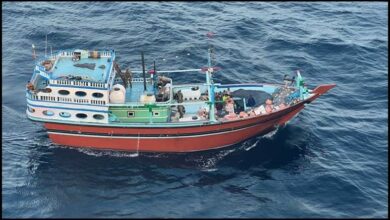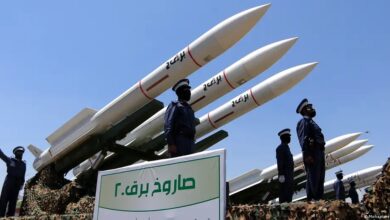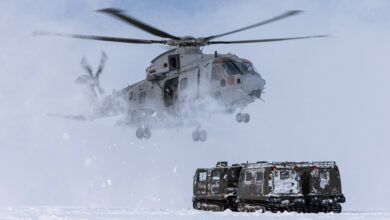UK seeks to form Europe-led Gulf maritime protection force
The United Kingdom is prepared to join an international maritime protection force led by Europe, foreign secretary Jeremy Hunt said on Monday, July 22, as tensions increase with Iran over seizures of oil tankers.
“We will now seek to put together a European-led maritime mission,” Hunt told the House of Commons. The plan could compliment recent U.S. proposals, he added, but “it will not be part of the U.S. maximum pressure campaign on Iran,” because the U.K. supports the preservation of the 2015 nuclear deal.
Hunt said that he had spoken to the foreign ministers of Oman, the United States, France, Germany, Italy, Finland, Spain and Denmark.
The Department of Transport has raised the security level for British-flagged shipping to level three and is advising against all passage in Iranian waters and in the Strait of Hormuz.
All British flagged ships are being asked to provide the government with notice so they can be afforded the best possible protected, Hunt said.
“It is of course not possible for the Royal Navy to provide escorts for every single ship or indeed eliminate all risks of piracy,” he said.
The Royal Navy has a total of 13 Type 23 frigates and 6 Type 26 destroyers to fulfil its commitments at home, in overseas territories and on international missions.
Operation Sentinel
The U.S. military’s Central Command on Friday announced that it is developing a multinational maritime operation in the Persian Gulf in light of escalating tensions with Iran in the region.
“The goal of Operation Sentinel is to promote maritime stability, ensure safe passage, and de-escalate tensions in international waters throughout the Arabian [Persian] Gulf, Strait of Hormuz, the Bab el-Mandeb Strait (BAM) and the Gulf of Oman,” CENTCOM said in a July 19 statement.
The statement did not list any foreign partners, but said U.S. officials are continuing to engage with allies in Europe, Asia and the Middle East.
“This maritime security framework will enable nations to provide escort to their flagged vessels while taking advantage of the cooperation of participating nations for coordination and enhanced maritime domain awareness and surveillance,” CENTCOM said.
There was no timetable given for the launch of the operation.
A international maritime task force is already in place in the Persian Gulf under the auspices of the 33-nation Combined Maritime Forces, based in Bahrain and under U.S. command.
Combined Task Force 152 is designed to enhance naval cooperation in the region, conducting maritime security operations operates and coordinating security cooperation with regional partners. CTF 152 consists of ships, aircraft and personnel from states including Saudi Arabia, Bahrain, Jordan, Qatar, Kuwait, UAE, the U.K. and the United States. France, Australia and Italy have also participated in the task force.
Increasing tensions over shipping
Hunt’s announcement followed a meeting of the COBR emergency committee of ministers and security officials convened by outgoing Prime Minister Theresa May on Monday to discuss how to respond after Iran’s Islamic Revolutionary Guard Corps seized the U.K,-flagged Stena Impero tanker on Friday in the strategic Strait of Hormuz.
“We do not seek confrontation with Iran but it is unacceptable and highly escalatory to seize a ship going about legitimate business through internationally recognised shipping lanes,” May’s spokesperson said as she chaired the meeting.
He said that the high volume of ships moving through the Strait of Hormuz “makes it impossible to escort vessels individually, but that Monday’s talks were to look at how to reassure commercial vessels in the region, as well as the U.K.’s response to Iran’s action.
That came two weeks after British authorities in a government of Gibraltar-led operation on July 4 seized an Iranian tanker on suspicion of breaching European Union sanctions against Syria. A Gibraltar court on Friday extended the detention of the Grace 1 supertanker by a further 30 days.
The E.U. on Saturday said the seizure of ships in the Strait of Hormuz is of “deep concern” and called for restraint. “In an already tense situation, this development brings risks of further escalation and undermines ongoing work to find a way to resolve current tensions,” a statement from the European External Action Service said.
Hunt spoke to his French and German counterparts on Sunday, and they agreed that “safe passage for vessels through the Strait of Hormuz is a top priority for European nations, while avoiding any possible escalation in the region,” a U.K. statement said.
‘Illegal interference’
Iranian authorities have insisted the Stena Impero’s crew – 18 Indians, including the captain, three Russians, a Latvian and a Filipino – are all in good health and are on board the ship which is anchored off the port of Bandar Abbas.
They say the Stena Impero was detained after the it failed to respond to distress calls and turned off its transponder after hitting a fishing boat.
“Seizing the British tanker was a legal measure by Iran,” Iranian government spokesperson Ali Rabiei told a news conference on Monday. “Iran confronted the ship [to ensure] the region’s security,” he said.
But in a Saturday letter to the United Nations Security Council setting out the U.K.’s view of the incident, charge d’affaires Jonathan Allen accused Iran of “illegal interference,” saying that the Stena Impero’s owners had said that the tanker was “in full compliance with all navigation and international regulations.”
Allen said there was no evidence of a collision and that the vessel had been in Omani waters with its transponder switched on when it was approached.
This map shows the Stena Impero was in Omani Territorial Sea when it was intercepted by Iranian forces.
Blue Line: Route SI was taking on Friday as it transited through the Strait of Hormuz.
Red Square: Location SI was intercepted, boarded and re-routed into Iranian Water. pic.twitter.com/kXrgzYoaQ0
— Dept for Transport (@transportgovuk) July 21, 2019
On Monday, oil traffic monitoring website Tanker Trackers released a video that it said showed the Stena Impero making an unexplained 90-degree turn from the west-bound shipping lane towards the east-bound lane before it was stopped.
Iran’s semi-official Fars news agency on Saturday published video footage showing the tanker being surrounded by speedboats before troops in balaclavas descend a rope from a helicopter onto the vessel.
In an audio recording of a radio exchange obtained by London-based maritime firm Dryad Global, an Iranian officer can be heard ordering the tanker to change course “immediately.”
The British Type 23 frigate HMS Montrose, which was in the Gulf at the time, intervenes to inform the Stena that its passage must not be impaired under international law.
The Iranians reply: “No challenge is intended … I want to inspect the ship for security reason.”
The U.K. government has warned its ships to avoid the Strait of Hormuz, a chokepoint for about a third of the world’s sea-borne oil.
The standoff comes at a sensitive time for the U.K., with May due to resign on Wednesday over her Brexit strategy, with former foreign minister Boris Johnson the overwhelming favorite to replace her.
Persian Gulf shipping tensions
The Strait of Hormuz, which runs between the Persian Gulf and and Gulf of Oman, is a key shipping route for international commerce.
Tensions in the Gulf have ramped up since May, when the U.S. boosted its military presence in response to what it claimed were indications of a “credible threat” from Iran.
The U.K. said on July 12 that three boats believed to be IRGC vessels tried to stop the merchant tanker British Heritage as it was entering the Strait of Hormuz from the Gulf.
The Royal Navy has since dispatched the Type 45 destroyer HMS Duncan to join Type 23 frigate HMS Montrose, and said on July 17 that it would send a second Type 23 frigate, the HMS Kent, to the region later this year. Montrose is due to come off task for pre-planned maintenance and crew change over in Bahrain.
Hunt said on Monday that Duncan will arrive in the region by July 29.
On July 18, the U.S. amphibious assault ship USS Boxer brought down an Iranian drone near the Strait of Hormuz after the unmanned aerial system “closed within a threatening range” of the ship and its crew, the Pentagon said.
In late June, the IRGC shot down a U.S. RQ-4 Global Hawk surveillance drone which it said violated Iranian airspace over the Kuh-e Mubarak region of Iran’s southern Homozgan province. The U.S. maintains the drone was operating in international airspace.
A week earlier, the Trump administration blamed the IRGC for attacks on Japanese and Norwegian fuel tankers in the Gulf of Oman, allegations that Iranian officials have denied. The Pentagon said Iran fired a surface-to-air-missile at an American drone the same day.
Washington had previously accused Iran of being behind May 12 attacks on four tankers anchored off the United Arab Emirates port of Fujairah at the entrance of the Strait of Hormuz.
Tensions between Tehran and the West have deepened since last year when President Donald Trump announced he was pulling the U.S. out of the 2015 Joint Comprehensive Plan of Action nuclear deal that was reached between China, France, Germany, Iran, Russia, the U.K. and the U.S.
Iran has accused the Europeans of failing to live up to their end of the deal by standing up to the U.S., and has begun enriching uranium at a level higher than allowed under the agreement – so far high enough to support nuclear power plants, but still far too low to be viable in a nuclear weapon.
With reporting from AFP












3 Comments